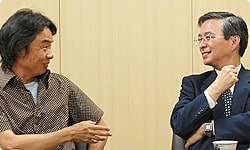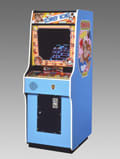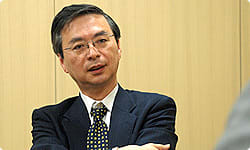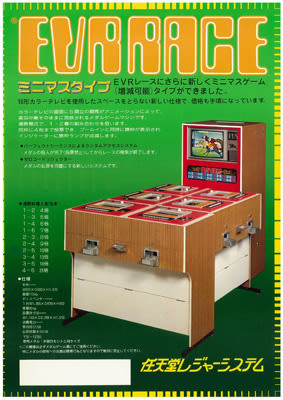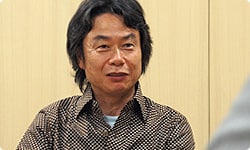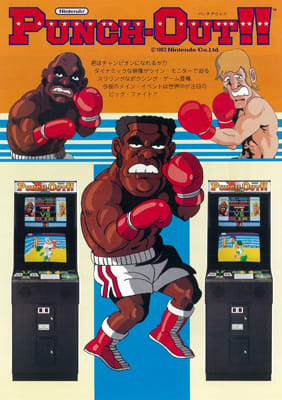The Proposition is to Use Two Televisions
Today, I am going to hear stories about Punch-Out!!. It may sound odd to call them this within the company, but some very special guests have joined us this time. I think Tanabe-san, who made the Wii version of Punch-Out!! might be feeling a little uncomfortable. (laughs)
Well, I am a little nervous. (laughs)
(laughs) Initially the game Punch-Out!! was born as an arcade game. Takeda-san from the Integrated Research and Development Division made the game and Miyamoto-san drew the artwork. We made two arcade games and Wada-san took over when they were to be ported to the Nintendo Entertainment System and Super Nintendo later.
That's right. I'm a bit nervous, too. (laughs)
Twenty two years have passed since the NES version of the game. And now Tanabe-san has just worked with Next Level Games Inc.1in Canada to make a Wii version of Punch-Out!!. And since we are on the subject, I think I would like to start by asking what lead to Punch-Out!! being created.
| 1 | Next Level Games Inc.: A Canadian software development company that created Super Mario Strikers (Nintendo GameCube) and Mario Strikers Charged (Wii). |
Okay. Hello, my name is Takeda, the game designer.
(roaring laughter)
You were the first, weren't you Takeda-san?
The first game designer?
That's right. He started making video games even before (Gunpei) Yokoi-san2.
Then he's Nintendo's first game designer.
Well, when you put it like that… (laughs)
| 2 | Mr. Gunpei Yokoi: When he worked at Nintendo, he was involved with such game hardware as the Game & Watch and the Game Boy, as well as other projects like ROB the NES robot and Dr. Mario. 1941-1997. |
I wish I could say this better, but I think almost everyone's impression of you is that you're very much a hardware person. Takeda-san has been working in home console hardware for the past several years and I think most people would be very surprised if they heard that you used to make software.
To start, could you tell me how it was decided to make the arcade version of Punch-Out!!?
There were two key reasons. We made Punch-Out!! around in 1983, so this story took place about 26 years ago, and at that time Nintendo was making a variety of coin-operated arcade games. However, we had an excess of televisions in stock to use for monitors.
You're going to start from there? (laughs)
Anyway, we had a bunch of televisions left over. (laughs)
We had to do something with them.
The Donkey Kong3 series was selling well and we just kept buying monitors for it at the same pace.
| 3 | Donkey Kong: Arcade game released in 1981.
|
The televisions were not being used.
Tons of them were in our Uji Plant.
So you're saying that there were a lot of excess televisions that had been purchased based on the estimated demand for arcade games.
That's correct. So we were given this proposition: Create a new arcade game that uses two televisions.
Two televisions? (laughs)
Two televisions could use up more stock than one.
Well, that's what happened anyway.
But the idea of using two televisions doesn't really lead to a boxing game.
Usually that's the case, but there was another reason. There was a new substrate, and it made it possible to zoom in on an object.
So what you mean by zooming in is that it could expand and shrink the object being displayed on the monitor, right?
Normally, if you made a game that used expanding/shrinking, it was something that involved flying, like a flight simulator, but we chose boxing as a theme because we thought there was a different way to use them.
Still, no matter how I think about it, I'm having a hard time mentally linking shrinking and expanding to a boxing game. (laughs)
I admit that you can't say they fit together very well.
This is a long story; do you mind?
Go ahead.
A long time ago, Takeda-san made an arcade game called EVR Race 4.
EVR Race |
The horse race game we released around 1975. When that was made, Miyamoto-san was…
Still a student. (laughs) EVR Race was the first video game Nintendo released.
So that's why Takeda-san is Nintendo's first game designer.
Right. EVR Race was a video game that used a videotape. It was a so-called mechanical game, so apparently it was really hard to maintain after Nintendo released it.
It was mechanical, so there were a lot of breakdowns.
Right. Also, when we were making Punch-Out!!, people were saying that laserdisc games 5 would be the next big thing. However, we knew that the maintenance would be really difficult if we sold laserdisc games worldwide.
| 5 | Laserdisc games: A name for videogames that used a laserdisc to display video. Also called LD games. |
In other words, we learned that maintenance was really difficult from our experience with EVR Race.
Right. But domestic sales people wanted something like the laserdisc, so we were investigating whether it could be done with semiconductors. That's why we were so interested in that substrate that could do zooming and show pictures at a similar size as a laserdisc. If you ask me though, it was a rascal of a project. (laughs)
A rascal? (laughs)
We had just released Donkey Kong then, and for example, to make an image like a rolling barrel, I had to make a pixel drawing for each frame.
Everything was done by hand.
That's why it took a lot of time and effort. When I asked if they could use processing on the hardware side to rotate the image, they would say, "it's not impossible." At the time, "it can't be done" was changing into "it's not impossible." A lot of new things were being created then, but most of it wasn't useful yet.
Everything was still being developed.
They said that we could make things bigger with zoom functions. But we still couldn't rotate. On the other hand, we could rotate it, but they couldn't display it larger. They also said that even if we enlarged it, we could only display one. "So we can only roll one barrel then?" (laughs)
(laughs) You can't make Donkey Kong with just one barrel.
At that point, we were going to use the substrate and we also had this proposition to use two televisions, so we looked into lining them up side by side and making a big racing game, but it wasn't nearly powerful enough to do something like that, because it could only enlarge one image.
(laughs)
Then Takeda-san said, "If we can only use one image, how about making it a person?" That's how the theme became boxing: we could have just one opponent. But one monitor would be enough for a boxing game, right?
You don't need two televisions. (laughs).
We were stuck for a little bit by that. But then, we thought that a boxing arena has big lights and banners hanging from the ceiling with things like "World Heavyweight Title Match" written on them. The game would have a lot of meters as well, so we thought maybe having two screens would be more fun and we tried stacking two screens vertically. It felt good, so we decided to use two screens.
The arcade game Punch-Out!! |
Following the release of Game & Watch, it was another game using dual screens (DS).

